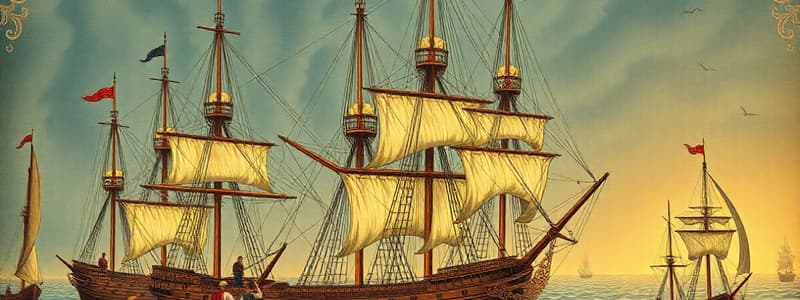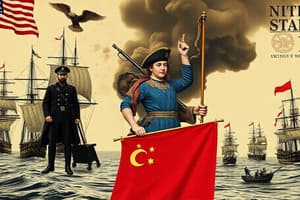Podcast
Questions and Answers
What primary threat prompted the U.S. Congress to consider establishing a national navy in the late 18th century?
What primary threat prompted the U.S. Congress to consider establishing a national navy in the late 18th century?
- British blockades preventing American trade with the West Indies.
- Aggression from French privateers against American merchant ships.
- Attacks on U.S. commercial vessels by Barbary pirates in the Mediterranean. (correct)
- Impending war with Spain over territory in North America.
What was the main point of contention among members of Congress regarding the establishment of a national navy?
What was the main point of contention among members of Congress regarding the establishment of a national navy?
- Whether the ships should be constructed in domestic or foreign shipyards. (correct)
- The potential impact on American neutrality amidst European conflicts.
- The appropriate number of ships to authorize in the initial naval fleet.
- The allocation of resources between naval buildup and territorial expansion.
What argument did opponents of naval buildup use to support their position against the Naval Act of 1794?
What argument did opponents of naval buildup use to support their position against the Naval Act of 1794?
- A strong navy would inevitably lead to conflicts with European powers.
- The United States should focus on self-sufficiency and avoid extensive trade, thus negating the need for naval protection. (correct)
- Naval forces were ineffective against Barbary pirates who operated from hidden bases.
- The cost of building and maintaining a navy would bankrupt the young nation.
Aside from naval buildup, what alternative solutions did some members of Congress propose to address the threat posed by the Barbary pirates?
Aside from naval buildup, what alternative solutions did some members of Congress propose to address the threat posed by the Barbary pirates?
How did the ongoing French Revolutionary Wars affect the decision to establish a U.S. Navy?
How did the ongoing French Revolutionary Wars affect the decision to establish a U.S. Navy?
Which of the following most accurately describes the initial composition of the naval fleet authorized by the Naval Act of 1794?
Which of the following most accurately describes the initial composition of the naval fleet authorized by the Naval Act of 1794?
What event immediately preceded the final passage of the Naval Act of 1794 by the U.S. Congress?
What event immediately preceded the final passage of the Naval Act of 1794 by the U.S. Congress?
How did Federalists generally view the establishment of a national navy, and why?
How did Federalists generally view the establishment of a national navy, and why?
Which ships were among the first six frigates authorized for construction under the Naval Act of 1794?
Which ships were among the first six frigates authorized for construction under the Naval Act of 1794?
What was the perceived relationship between the natural resources of the U.S. and the necessity for a navy, according to opponents of the Naval Act?
What was the perceived relationship between the natural resources of the U.S. and the necessity for a navy, according to opponents of the Naval Act?
Flashcards
Naval Act of 1794
Naval Act of 1794
Act authorizing the construction of the Navy's first six frigates to protect U.S. commercial vessels from Barbary pirate attacks.
Barbary Pirates
Barbary Pirates
Attacks by pirates in the Mediterranean and Atlantic waters against U.S. commercial vessels.
Purpose of the Naval Act of 1794
Purpose of the Naval Act of 1794
To protect U.S. commercial vessels, address Barbary pirate attacks, and maintain neutrality during French Revolutionary wars.
First Six U.S. Frigates
First Six U.S. Frigates
Signup and view all the flashcards
British Trade Blockade
British Trade Blockade
Signup and view all the flashcards
Study Notes
- President Washington signed the Naval Act of 1794 on March 27, 1794
- The Naval Act of 1794 authorized the construction of the Navy’s first six frigates
- Months before that, Congress passed a resolution to establish a national navy to protect U.S. commercial vessels
- The vessels needed protection from Barbary pirates in the Mediterranean and nearby Atlantic waters
- The resolution passed by a narrow margin of 46 to 44 votes
- A nine-man committee was created to study issues of naval buildup, focusing on cost and size
- On February 6, 1794, the committee suggested four 44-gun ships and two 20-gun ships
- Congressional debate on the committee's recommendation lasted until March 10
- The debate was based on years of indecision on the issue of a national navy
- There was agreement that the British were behind the Barbary attacks and were endangering U.S. trade in the West Indies
- Opinions differed on whether a navy would help or hurt American neutrality
- The U.S. faced the dangers of the French Revolutionary wars
- Spain and Britain, with North American colonies, were against revolutionary France, the Americans’ only European ally
- The alliance with France was at risk as the French Revolution had excesses
- As part of its war against the British, the French state used privateers to harass American ships
- A merchant vessel from a U.S. port had to deal with European ships of war, privateers, and Barbary pirates in the Atlantic
- Supporters of the bill argued a navy was needed to defend American commerce
- Federalists and urban-dwellers favored a navy due to their reliance on maritime trade
- Britain was blocking U.S. exports to France and U.S. imports from the West Indies
- Opponents of naval buildup believed U.S. natural resources eliminated the need for trade with Europe
- They believed that American self-sufficiency through rural productivity was the better approach, a key Democratic-Republican priority
- James Madison and William B. Giles worried about cost, debt, and government overreach
- They wanted a diplomatic solution or tributary payments for the Barbary pirates
- Economic retaliation was considered if other methods failed, but caution urged regarding military actions
- In early March 1794, attacks on American ships were increasing
- Merchant ships like Thomas, Hope, Dispatch, George, Olive Branch, Jane, President, Polly, and Minerva were taken by Barbary pirates in late 1793
- American vessels were falling victim to privateers and ships of war from both Britain and France
- Arguments for a navy prevailed, and on March 27, 1794, Congress passed the “Act to provide a Naval Armament"
- The act promised the president six frigates, which became the new Navy's first ships of war
- The ships were the United States (launched 1797), Constellation (1797), Constitution (1797), Congress (1799), Chesapeake (1799), and President (1800)
Studying That Suits You
Use AI to generate personalized quizzes and flashcards to suit your learning preferences.




